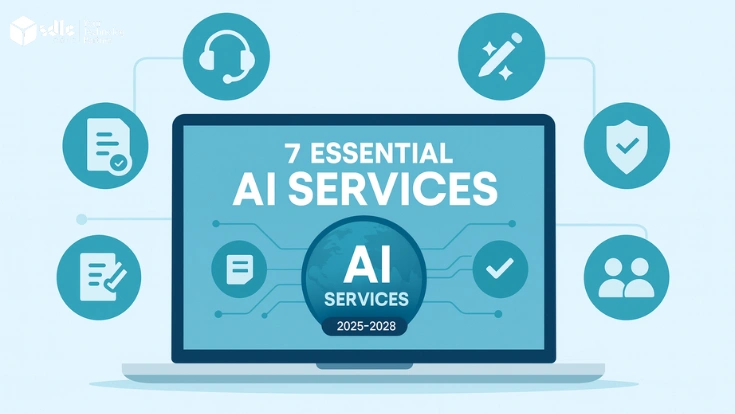Introduction
As the world faces intensifying sustainability challenges rising global temperatures, depleting energy resources, and mounting waste technology has emerged as both a cause and a potential cure. AI for Green Tech represents this intersection where innovation meets ecology. From the earliest sparks of machine intelligence, scientists and engineers recognized its potential to revolutionize how we manage the planet’s most critical systems. With the support of AI development services and custom AI solutions, organizations are now driving a green revolution that redefines how we live, consume, and conserve.
AI for Green Tech refers to the application of artificial intelligence to enhance environmental sustainability, optimize resource utilization, and mitigate the effects of climate change. By analyzing vast datasets and predicting outcomes, AI makes energy consumption smarter, agriculture more efficient, and waste management more sustainable.
Energy: Smarter grids and predictive maintenance reduce waste and emissions.
Agriculture: Precision farming maximizes yields while conserving water and soil.
Climate: Advanced models forecast and mitigate environmental risks.
Waste: Intelligent recycling and logistics streamline resource recovery.
As a result, AI for Green Tech is paving the way toward a cleaner, smarter, and more resilient future where technology and sustainability evolve hand in hand.
1. Core Principles and Architecture of AI for Green Tech
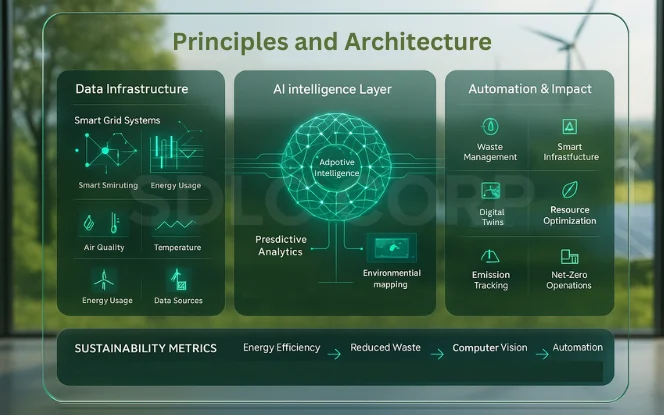
The architecture of AI for Green Tech blends data-driven intelligence with automated control to achieve measurable sustainability outcomes. It operates through a layered system that gathers environmental information, processes it using machine learning, and applies real-time optimization to minimize waste and emissions. Below is a breakdown of its core principles and structural components.
AI Applications in Green Technology
Green technology systems generate data from energy grids, sensors, climate models, and environmental monitoring platforms. AI helps analyze this data to support efficiency, sustainability, and impact measurement. In many initiatives, AI development services are used to integrate data sources and enable intelligent decision-making across green tech operations.
Data Infrastructure in AI for Green Tech
- AI for Green Tech relies on a strong foundation of sensors, IoT networks, and open data repositories.
- These systems capture continuous environmental data—such as air quality, temperature, soil health, and energy usage.
- Furthermore, these connected systems enable real-time monitoring, ensuring decisions are based on evidence, not estimation.
- IoT devices in smart grids, for instance, detect fluctuations in energy demand and adjust distribution accordingly.
- Open climate data repositories empower global research collaborations for sustainability innovation.
Machine Learning Models for AI for Green Tech
- Machine learning forms the intelligence layer of Green Tech.
- Predictive analytics anticipates future sustainability challenges like power surges or crop stress.
- Reinforcement learning allows systems to self-improve through trial and feedback, optimizing outcomes over time.
- Neural networks analyze complex environmental datasets—identifying patterns in pollution, temperature, or resource use.
- Moreover, real-time optimization enables AI for Green Tech systems to adapt instantly, balancing performance and sustainability.
Automation and Control Systems in AI for Green Tech
- Automation transforms insights into tangible actions for greener operations.
- Smart controllers and digital twins simulate real-world systems to enhance efficiency.
- Feedback loops allow AI for Green Tech to continuously refine its performance.
- Consequently, industries like energy and waste management can operate autonomously while reducing carbon footprints.
Learn More : Digital Twins in AI
Architecture : Layers and Functions
| Layer | Function | Example |
|---|---|---|
| Data | Capture environmental signals | Smart meters, IoT sensors |
| Model | Predict sustainability outcomes | Energy load forecasting |
| Action | Optimize processes | AI-controlled solar grids |
| Feedback | Refine and adapt systems | Self-learning control loops |
Through this structured integration of data, intelligence, and automation, AI creates a continuously improving ecosystem—one that senses, learns, and acts for a sustainable future.
2. AI for Green Tech in Renewable Energy & Smart Grids
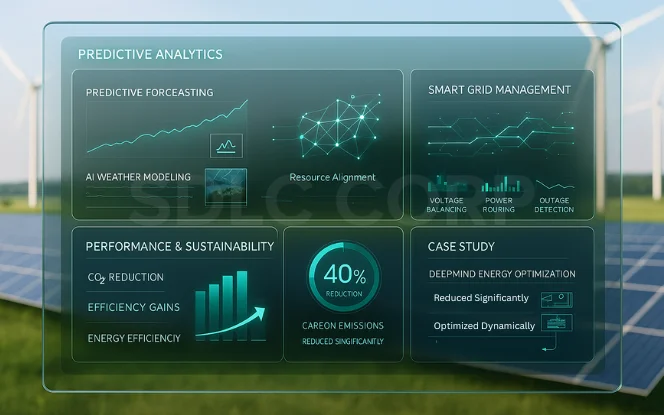
The integration of AI in renewable energy and smart grids marks a critical evolution in how societies generate, distribute, and manage power sustainably. As the global energy mix transitions toward solar, wind, and hydro sources, the complexity of maintaining balance and reliability grows. Artificial intelligence bridges this gap by analyzing vast data streams, forecasting resource availability, and automating grid operations. Consequently, AI for Green Tech ensures renewable systems operate at peak efficiency, minimizing waste and improving resilience.
Explore : AI for Energy
Predictive Analytics for Renewable Energy
- AI for Green Tech utilizes predictive analytics to forecast renewable energy availability with remarkable accuracy.
- Advanced algorithms analyze historical weather patterns, satellite imagery, and real-time sensor data to predict solar irradiance and wind velocity.
- Therefore, operators can align energy production with storage capacity—charging batteries when generation is high and discharging during demand peaks.
- This predictive capability minimizes downtime, prevents grid overload, and ensures stable energy delivery even in fluctuating weather conditions.
- Moreover, predictive maintenance models detect early signs of equipment failure in wind turbines or solar inverters, reducing operational disruptions and extending asset lifespans.
AI-Enabled Smart Grids for Green Tech
- Smart grids empowered by AI for Green Tech balance energy flow in real time, ensuring optimal distribution between producers and consumers.
- Intelligent systems manage voltage fluctuations, detect outages, and reroute power automatically to maintain supply.
- Machine learning models continuously learn from energy consumption data, adapting grid behavior dynamically.
- These grids form the backbone of next-generation sustainability, where energy is distributed as efficiently as it is generated.
Key Benefits of AI-Enabled Smart Grids:
- Increased Renewable Reliability: AI forecasts and adjusts supply according to environmental conditions.
- Reduced Operational Costs: Predictive maintenance and automation lower labor and repair expenses.
- Lower Carbon Emissions: Efficient energy flow reduces fossil-fuel dependency.
- Improved Customer Efficiency: Consumers access real-time data to manage usage and reduce bills.
Case Example – Google DeepMind Energy Optimization
Google’s DeepMind project is a landmark example of AI f in action. By applying reinforcement learning algorithms to manage data center cooling systems, DeepMind achieved a 40% reduction in cooling energy consumption. This optimization was made possible by real-time monitoring of temperature, power loads, and airflow, allowing AI to autonomously adjust cooling operations without human input.
| Metric | Before AI Integration | After AI Integration | Improvement |
|---|---|---|---|
| Cooling Energy Use | 100% baseline | 60% of baseline | 40% reduction |
| Carbon Emissions | High | Reduced significantly | Sustainability gain |
| Operational Cost | Unoptimized | Optimized dynamically | Major savings |
In conclusion, AI empowers renewable systems and smart grids to become more intelligent, resilient, and scalable. By forecasting energy generation, optimizing grid performance, and automating control, AI ensures that the future of power is not only sustainable—but also smarter and more efficient than ever.
Learn More About : Generative AI for Energy
3. AI for Green Tech in Agriculture & Sustainable Food Systems
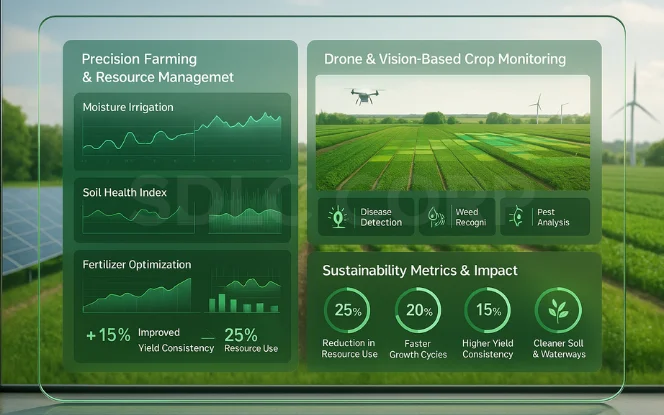
Agriculture stands at the heart of sustainability, feeding a growing population while facing mounting pressure from climate change and resource scarcity. AI for Green Tech plays a transformative role in modernizing farming practices—making them data-driven, predictive, and efficient. Through intelligent monitoring, precision resource management, and yield forecasting, farmers can achieve higher productivity with minimal environmental impact. Consequently, AI for Green Tech enables agriculture to evolve from traditional methods to smart, sustainable ecosystems that nourish both people and the planet.
Precision Farming Using AI for Green Tech
Precision farming harnesses AI for Green Tech to optimize every step of the agricultural process. Smart irrigation systems analyze soil moisture, weather patterns, and plant health to deliver water only where and when it’s needed. Machine learning models also predict soil nutrient levels, helping farmers apply fertilizers more accurately and reduce chemical runoff. Furthermore, AI-driven crop mapping tools create detailed field insights, guiding sustainable land use and resource allocation. As a result, farms experience higher yields with fewer resources—balancing economic and ecological goals simultaneously.
Check Out : AI for FoodTech
Drone and Vision-Based Monitoring
AI-powered drones and computer vision systems revolutionize how farmers monitor crop health. These technologies capture high-resolution aerial images to detect early signs of disease, weed growth, or pest infestation that might otherwise go unnoticed. Deep learning models analyze visual data, classifying plant conditions in real time and suggesting targeted interventions. Therefore, AI for Green Tech minimizes pesticide overuse and prevents widespread crop loss, enhancing both sustainability and profitability.
Predictive Yield Modeling with AI for Green Tech
Predictive modeling is another key advancement of AI for Green Tech. By processing years of weather, soil, and crop data, machine learning algorithms forecast yield outcomes and optimize harvest planning. This intelligence allows farmers to align logistics, storage, and distribution efficiently—reducing post-harvest waste and improving food system resilience. Moreover, these predictive systems support better policymaking in sustainable agriculture, ensuring equitable food distribution across regions.
Advisory and Governance for Sustainable AI
AI systems used in green technology often influence regulatory reporting and sustainability metrics. Governance frameworks help ensure transparency, accountability, and data integrity. An AI consulting company may support organizations in aligning AI usage with environmental standards and compliance requirements.
Quick Facts: Impact of AI for Green Tech in Agriculture
- 25% reduction in resource use through precision irrigation and nutrient management.
- 20% faster crop growth cycle achieved via optimized environmental conditions.
- 15% higher yield consistency due to predictive analytics and disease prevention.
- Significant decrease in chemical runoff, supporting cleaner soil and waterways.
In essence, AI for Green Tech transforms agriculture into a symbiotic partnership between technology and nature—empowering farmers to grow more with less while protecting the planet’s vital ecosystems.
Read More : AI for Agritech
4. AI for Green Tech in Climate Modeling & Environmental Intelligence
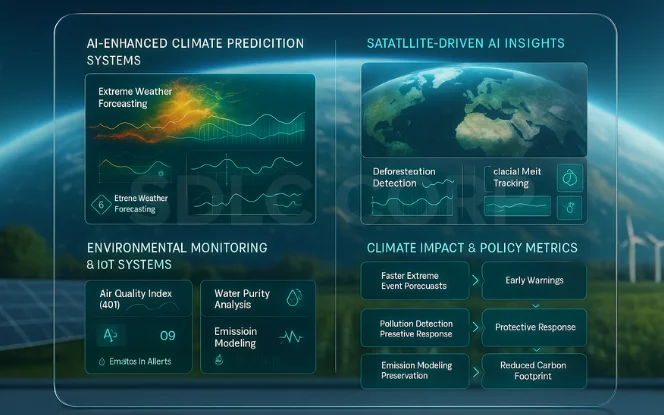
Climate change presents one of humanity’s most complex challenges, demanding tools capable of understanding and responding to global-scale environmental shifts. AI for Green Tech is at the forefront of this transformation combining predictive analytics, satellite imaging, and real-time monitoring to create a deeper understanding of our planet’s systems. Consequently, governments, scientists, and industries can take proactive measures rather than reacting to disasters after they occur.
AI-Enhanced Climate Prediction Systems
AI for Green Tech strengthens climate prediction by analyzing massive datasets from weather stations, ocean buoys, and satellites. Machine learning models detect intricate climate patterns and forecast extreme events such as heatwaves, floods, and hurricanes with far greater accuracy than traditional models. Consequently, these systems allow policymakers and communities to prepare earlier, minimizing human and economic losses.
Therefore, AI for Green Tech not only predicts environmental crises but also helps design adaptive infrastructure and sustainable resource management strategies. In addition, predictive modeling supports long-term climate scenario planning, helping nations align with global emission targets.
Satellite-Driven AI for Green Tech
AI algorithms process satellite imagery to monitor Earth’s changing surface in real time. From tracking deforestation in the Amazon to observing glacier melt in the Arctic and detecting ocean acidification, AI for Green Tech enables continuous, high-resolution environmental intelligence. These insights are essential for enforcing conservation policies and verifying the impact of climate initiatives. Moreover, integrating satellite data with AI allows for near-instant detection of illegal logging, wildfire outbreaks, or habitat loss—critical for rapid intervention.
Read Also : AI for Environmental Management
In summary, AI for Green Tech transforms environmental intelligence into actionable insight helping humanity safeguard the planet through foresight, precision, and innovation.
5. AI for Green Tech in Smart Buildings & Sustainable Cities
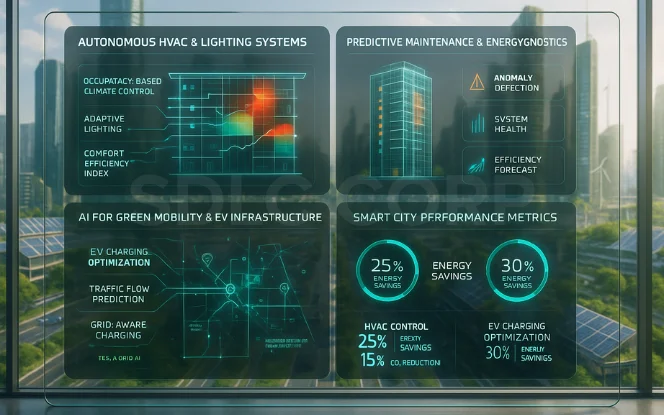
Urban areas account for over 70% of global carbon emissions, making them a critical focus for sustainable innovation. AI for Green Tech is revolutionizing how cities consume energy, manage infrastructure, and support cleaner living environments. By embedding intelligence into building systems and mobility networks, AI enables automation, predictive efficiency, and optimized resource utilization. Consequently, smart cities powered by AI for Green Tech are becoming living ecosystems responsive, energy-efficient, and environmentally adaptive.
Autonomous HVAC and Lighting Systems
In modern buildings, AI for Green Tech powers autonomous HVAC and lighting systems that continuously adapt to occupancy patterns and natural daylight levels. Machine learning algorithms process real-time data from sensors to adjust temperature, ventilation, and lighting intensity automatically. Moreover, this ensures occupant comfort while significantly reducing operational costs and energy waste. Smart systems also learn from user behavior over time, fine-tuning energy use to align with sustainability goals and carbon-neutral objectives.
Predictive Maintenance in AI for Green Tech
Predictive maintenance uses AI analytics to detect inefficiencies or equipment faults before they escalate. By analyzing sensor data, AI for Green Tech identifies anomalies such as air leaks, inefficient boilers, or failing ventilation units that contribute to unnecessary energy loss. Consequently, facility managers can schedule timely repairs, extend asset lifespans, and prevent energy waste. This proactive approach transforms traditional maintenance models into sustainable, data-driven practices.
Know About : AI for Smart Cities
AI for Green Mobility and EV Charging
AI is also driving the next generation of smart transportation infrastructure. AI for Green Tech optimizes electric vehicle (EV) charging by analyzing renewable energy surpluses and grid demand. It determines ideal charging times to reduce strain on the power grid and enhance cost savings for users. Furthermore, AI systems in smart cities coordinate public transit schedules and traffic lights to minimize congestion and emissions.
Performance Impact of AI Applications in Smart Cities:
| Application | Savings | CO₂ Reduction | Example |
|---|---|---|---|
| HVAC Control | 25% | 15% | BrainBox AI |
| EV Charging | 30% | 18% | Tesla Grid AI |
Through intelligent automation, predictive maintenance, and green mobility systems, AI for Green Tech transforms cities into sustainable ecosystems balancing innovation, comfort, and environmental responsibility.
6. AI for Green Tech in Waste Management & Circular Economy
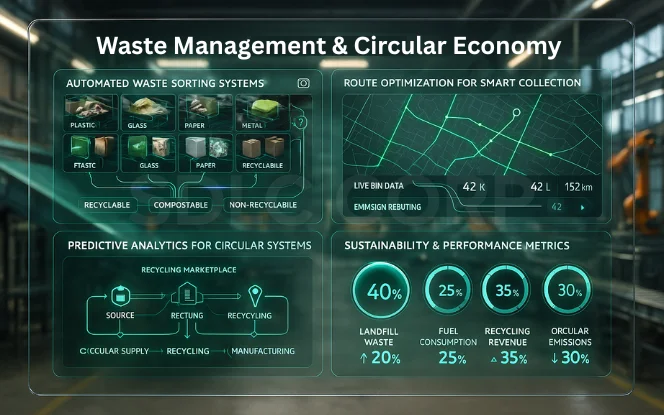
Efficient waste management is a cornerstone of environmental sustainability, and AI for Green Tech is revolutionizing this domain by transforming how waste is collected, sorted, and repurposed. Through automation, data analytics, and smart connectivity, AI enables cities and industries to close the loop on materials—paving the way for a true circular economy. Consequently, resources are conserved, emissions are reduced, and economic value is recovered from what was once considered waste.
Automated Waste Sorting via AI for Green Tech
- Vision-based robotics powered by AI for Green Tech improve recycling accuracy and efficiency.
- Cameras and sensors analyze color, texture, and shape to distinguish between different materials (plastic, glass, paper, metal).
- Machine learning models enable real-time identification of recyclables, reducing contamination and human error.
- Moreover, automated sorting lines increase throughput and reduce the burden on manual labor.
- As a result, recycling facilities achieve higher recovery rates and minimize landfill waste.
Route Optimization in AI-Driven Waste Collection
- AI for Green Tech optimizes waste collection routes through IoT-enabled smart bins.
- Sensors monitor fill levels and send live updates to central systems.
- Machine learning algorithms analyze traffic, route density, and fuel data to plan efficient pickup schedules.
- Therefore, collection trucks operate only when needed, cutting down on unnecessary trips.
- This results in significant fuel savings, lower emissions, and reduced operational costs.
Predictive Analytics for Circular Systems
- Predictive models in AI for Green Tech connect waste sources with recyclers and manufacturers.
- These systems forecast material demand and availability, enabling marketplace intelligence for recycled goods.
- Consequently, waste becomes a valuable resource—supporting sustainable production cycles.
- Businesses gain both environmental and financial benefits through resource recovery and reuse.
Key Benefits of AI for Green Tech in Waste Management
- Less landfill overflow through accurate sorting and recycling automation.
- Lower fuel use due to AI-optimized collection routes.
- Higher recycling revenue from efficient circular material flow.
- Reduced greenhouse gas emissions supporting global climate goals.
- In essence, AI for Green Tech turns waste into opportunity—creating intelligent, regenerative systems that drive sustainability and economic resilience.
7. Future Outlook, Ethical AI, and Sustainable Adoption
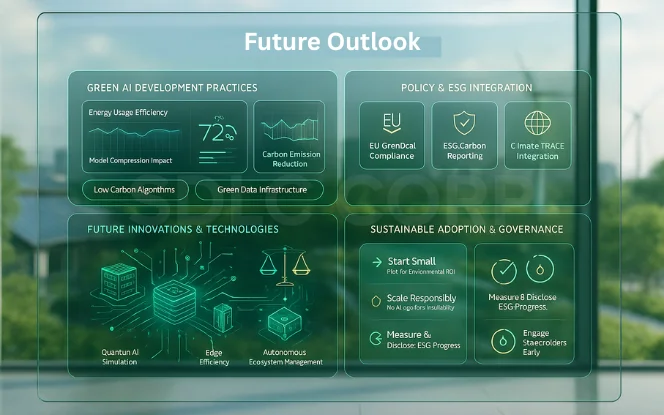
The future of AI for Green Tech depends not only on technological progress but also on responsible, ethical, and transparent adoption. As artificial intelligence continues to evolve, the challenge lies in ensuring that the very tools designed to protect the planet do not contribute to its degradation. Consequently, organizations are moving toward Green AI—where sustainability is built into the lifecycle of algorithms, from design to deployment. The next decade will see AI for Green Tech evolve from efficiency-driven systems to self-sustaining, ethically governed ecosystems that power the global green transition.
Green AI Development Practices
- AI for Green Tech must be developed with environmental efficiency at its core.
- Data centers powering large AI models consume immense energy; therefore, companies are shifting to renewable-powered cloud infrastructure.
- Developers are optimizing algorithms to reduce computational waste and carbon footprint without compromising accuracy.
- Moreover, model compression and efficient neural architectures help minimize training time and energy demand.
- As a result, AI for Green Tech becomes both environmentally responsible and technically scalable.
Policy & ESG Integration in AI for Green Tech
- Governments and corporations are aligning AI for Green Tech with global sustainability policies.
- Integration with the EU Green Deal, Climate TRACE, and corporate ESG (Environmental, Social, and Governance) frameworks ensures accountability.
- These initiatives promote transparency in carbon tracking and AI model reporting.
- Consequently, ethical AI governance supports measurable climate action and responsible innovation.
- Public-private collaborations further ensure that AI adoption aligns with long-term planetary goals.
Future Innovations and Next Steps
- Emerging technologies like quantum AI, edge computing, and autonomous sustainability platforms will redefine the next frontier of AI for Green Tech.
- Quantum computing could enable ultra-efficient simulations for climate modeling and material discovery.
- Edge AI will reduce latency and energy costs by processing data closer to its source.
- Furthermore, autonomous platforms will manage renewable grids, waste cycles, and smart ecosystems with minimal human oversight.
Actionable Insights for Sustainable AI Adoption:
- Start small → pilot project to test feasibility and environmental ROI.
- Scale using MLOps for sustainability, ensuring continuous optimization.
- Measure, iterate, and disclose progress through transparent ESG metrics.
- Engage stakeholders early to align innovation with policy and ethics.
In conclusion, the path forward for AI for Green Tech is clear: responsible innovation, guided by ethical frameworks and sustainability-first design, will enable technology to serve not just human progress—but planetary balance.
Check This : How Blockchain Developers Contribute to Sustainable Agriculture
Conclusion
AI for Green Tech represents the convergence of intelligence and sustainability transforming how we produce energy, manage resources, and protect the environment. Its value lies in measurable impact: lower emissions, optimized efficiency, and smarter systems. With AI development solutions, organizations can baseline current performance, launch pilot projects, and scale proven models through MLOps-driven sustainability practices.
In the near term, adopting AI for Green Tech means committing to data-driven environmental action that delivers both economic and ecological value. For organizations ready to lead in sustainable innovation, exploring tailored AI solutions or requesting a Green AI implementation checklist can be the first step toward building a smarter, greener, and more resilient future.
FAQs
1. What problems does AI for Green Tech solve first?
AI for Green Tech addresses critical issues like energy inefficiency, waste management, and climate prediction. It optimizes operations to reduce emissions and resource use across key industries.
2. How do we measure ROI for AI for Green Tech projects?
ROI is measured through energy savings, reduced operational costs, and carbon footprint reduction. Benchmark before deployment, track sustainability metrics, and compare post-implementation results.
3. Is AI for Green Tech viable for SMEs with limited data?
Yes. AI for Green Tech can start small using cloud-based analytics, open datasets, and modular solutions. SMEs can pilot projects before scaling for maximum impact.
4. How to reduce the carbon cost of training models?
Use renewable-powered data centers, optimize algorithms for efficiency, and employ model compression. Training smarter—not larger—minimizes energy consumption and emissions.
5. Which standards help verify AI for Green Tech outcomes?
Standards like ISO 50001 (Energy Management) and the GHG Protocol provide frameworks to measure, verify, and report the sustainability impact of AI for Green Tech systems.




